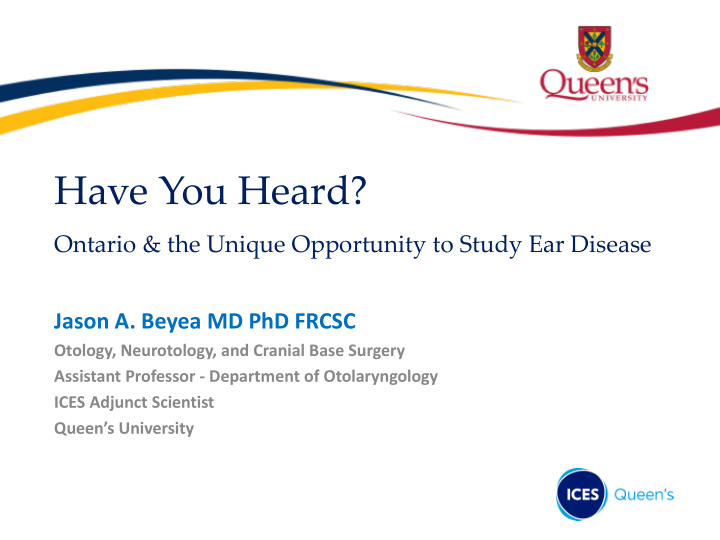



Have You Heard? Ontario & the Unique Opportunity to Study Ear Disease Jason A. Beyea MD PhD FRCSC Otology, Neurotology, and Cranial Base Surgery Assistant Professor - Department of Otolaryngology ICES Adjunct Scientist Queen’s University
Disclosures • I have no actual or potential conflicts of interest in relation to this educational program • This presentation includes data provided through ICES, the Ontario Ministry of Health and Long-Term Care, and CIHI. The analyses, conclusions, opinions, and statements herein are those of the authors and not necessarily those of these organizations. No endorsement is intended or should be inferred.
The Ear • Hearing • Vestibular (balance) function • Objectives 1. Describe the unique opportunity Ontario presents for the study of ear disease 2. Describe new risk factors for ear disease 3. Describe the results of current treatment options www.brighamandwomensfaulkner.org
What happens when the ear doesn’t work well? Recurrent infections • Pain – Need for antibiotics – Most common reason for antibiotics in young children • Lost days at work/school – Hearing loss • Speech & communication difficulties – Impaired functioning at work – Social isolation – Tinnitus (ringing in the ears) – Hearing Loss Normal Ear infection Hole in Eardrum Skin Cyst Hawke Library
Can we prevent/slow this progression? • Acute infection – Antibiotic therapy • Recurrent infections and fluid build-up – Tympanostomy Tubes (“ear tubes”) • Most common outpatient surgery performed on children – Drain fluid – Improve hearing – Reduce bacterial infections
Challenges Facing Research on Ear Disease Challenges Unique Ontario Opportunity Studies with small sample size Large population (14+ million) Incomplete datasets/multiple payers One payer (OHIP): Comprehensive Low incidence of complications Large ICES dataset This size and universality is unique in the world
With this tremendous opportunity, let‘s answer some important questions.
Build a Cohort OHIP Surgical Billings Filter for Pediatric Patients, Ear Tubes 193,880 Children who received Ear Tubes Detailed Analysis
Key Findings • Risk of needing 2 or more sets of ear tubes – 1 in 3.5 children • Gender disparity – 60-63% of patients were male • Ontario pediatric population: 51.1-51.4% male • Children with Asthma/reactive airways much more likely to have ear disease – 30.9% of cohort • Canadian pediatric asthma prevalence 13.4%
Key Findings Risk of Tube Reinsertion 2.0 Adjusted Relative Risk of Tube Reinsertion 1.8 1.6 1.4 1.2 1.0 0.8 0.6 0.4 0.2 0.0 5 1 5 2 5 3 5 4 5 5 5 6 6 7 8 9 0 1 2 3 4 5 6 7 8 . - . - . - . - . - . - 1 1 1 1 1 1 1 1 1 0 5 1 5 2 5 3 5 4 5 5 5 - . - . - . - . - . - . 0 0 1 1 2 2 3 3 4 4 5 5 Age at First Tube Insertion *all p<0.05, except 3.5 to 4.5
Key Findings Relative Risk of Needing More Tubes ≥2 Tube Surgery ≥3 Tube Surgery ≥4 Tube Surgery ≥5 Tube Surgery Male 1.056* 1.075* 1.082* 0.996 Asthma 1.075* 1.146* 1.247* 1.333* Prematurity 1.143* 1.286* 1.442* 1.596* Cleft lip/palate 1.493* 2.328* 3.322* 4.847* All of these factors increase the risk *p<0.001
Key Findings Relative Risk of Needing More Tubes ≥2 Tube Surgery ≥3 Tube Surgery ≥4 Tube Surgery ≥5 Tube Surgery Adenoidectomy 0.614* 0.485* 0.461* 0.424* Tonsillectomy 0.600* 0.513* 0.502* 0.490* +/- Adenoids These adjuvant surgeries reduce the risk *p<0.001
Conclusions • Higher risk of ongoing ear disease: – Males – Asthmatics – Born premature – Cleft lip/palate • Reduced risk of ongoing ear disease: – Adenoidectomy – Tonsillectomy
What about hearing loss?
Current Guidelines: Hearing Assessment • All children should undergo a hearing test prior to ear tube surgery. – Is this happening? Rosenfeld et al.2013
Key Findings Before Ear Tubes Percentage Receiving Hearing Tests After Ear Tubes We are not meeting our guidelines
Key Findings Introduction of the guidelines had no effect on physician behavior
Conclusions • Hearing tests are performed much less often than expected, but this is improving • Introduction of guidelines did not change physician behaviour • Significant geographic variability in hearing testing
Ear Tubes are meant to prevent worsening ear disease. Is this reality?
Summary • Many new risk factors (some modifiable) for ear disease • Guideline adherence remains an ongoing opportunity We continue to learn how to better care for our patients
Acknowledgements Dr. Stephen F. Hall Dr. Paul Nguyen (ICES) Dr. Josee Paradis (Western) Vic Sahai Emily Rosen Bonnie Cooke Trina Stephens Department of Audiology - HDH Queen’s University New Clinician Scientist Program ICES Queen’s
Have You Heard? Ontario & the Unique Opportunity to Study Ear Disease Jason A. Beyea MD PhD FRCSC Otology, Neurotology, and Cranial Base Surgery Assistant Professor - Department of Otolaryngology ICES Adjunct Scientist Queen’s University
Recommend
More recommend